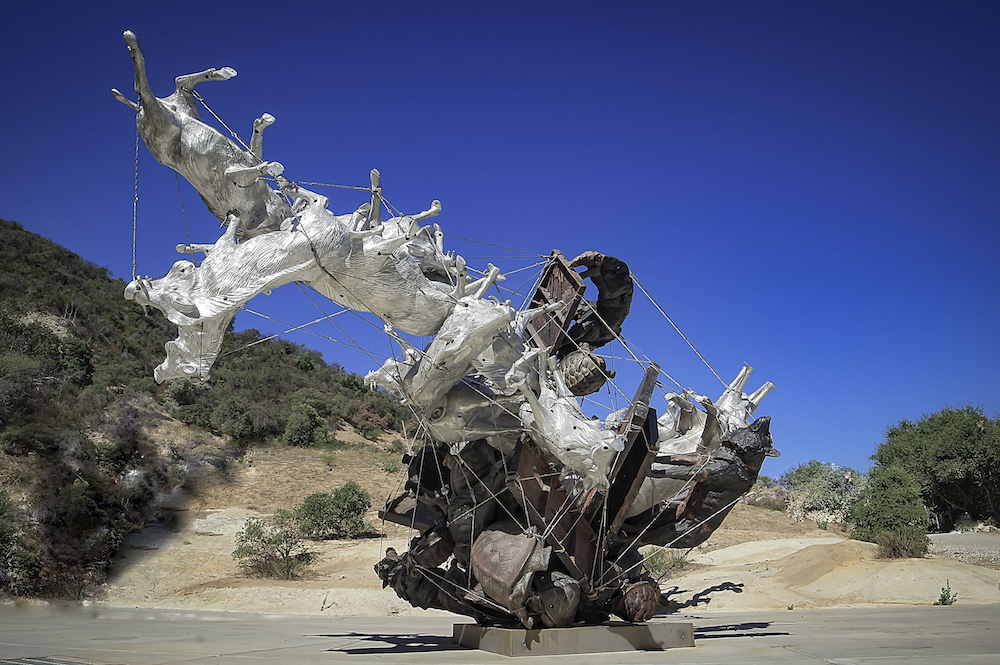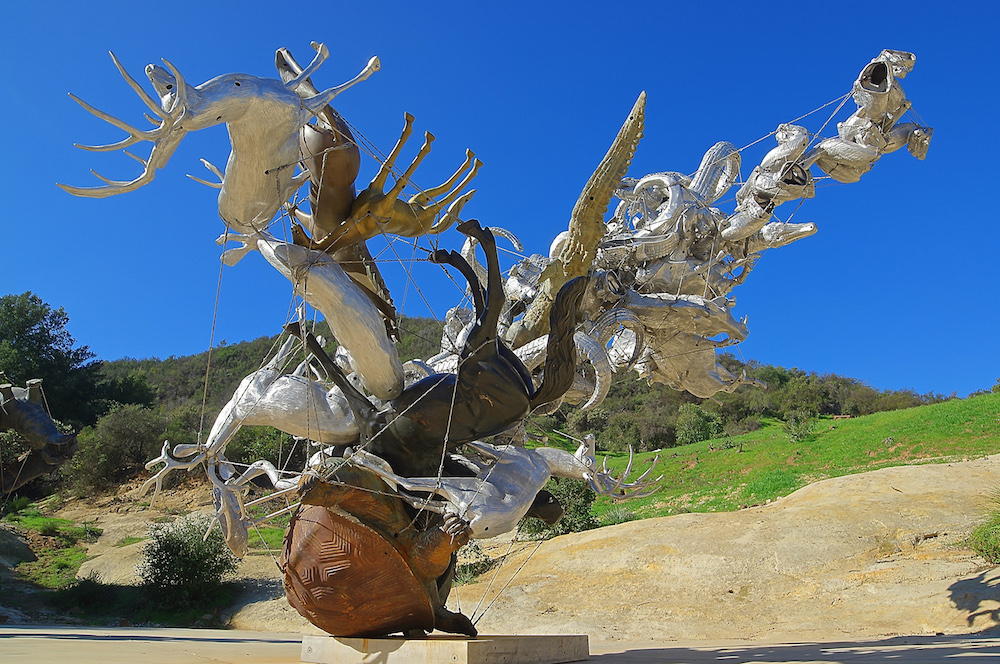
Cast iron, aluminum, stainless steel armature and stainless steel wire cable, 284.5 × 421.6 × 351.1 cm
Nancy Rubins’s first solo exhibition in London—Diversifolia—
opens on 7 February at Gagosian Gallery. The show encapsulates the artist’s experimental and buoyant practice, renowned for her monumental work, in which she builds large, arresting sculptures through rigging multiple clusters of “junk” objects together with tensile cables. This specific engineering technique, which precisely combines compression and tension (and is more commonly associated with the physics of suspension bridges), is known as “tensegrity”. The work is somewhat genre-defying too, subverting the tradition of American macho-modernist concrete by invoking a form of theatrical accumulation and bricolage. Despite all the aggregated parts, the result is always cohesive, sustaining a constant play between balance, energy and dynamic tension.
“You’re getting a physics education while you’re looking at this work.”
When I meet Rubins onsite at Gagosian—three weeks before her show opens—she immediately introduces me to the group of men huddled around one of her large-scale sculptures. While I shake their hands she encourages, “I have a really great crew. These fellas have been working with me forever.” Rubins and her team are engaged in the elaborate process of carefully rebuilding and reassembling the work. The gallery is filled with scaffolding, moving apparatus and trolleys. “We built all these sculptures in my studio,” she explains. Rubins has lived in the bohemian community of Topanga Canyon in Los Angeles since 1981, when she first moved with her late husband Chris Burden.

Cast iron, brass, bronze, aluminum, stainless steel armature and stainless steel wire cable, 433.1 x 548.6 x 489 cm
With over eighty acres of land, much of her work is made in the outdoors. Although the installation logistics may be slow, the initial experience is improvisational, with creative decisions being made fast and spontaneously. “After we built them, they were very carefully mapped and marked, then we disassembled them, sent them overseas on ships, packed into nine twenty-three-foot containers known as ‘tall boys’, and now we have to put them back together like very complex puzzles.” There is science within the spectacle. The viewer is encouraged to have an active relationship with the object, through trying to understand how it is formed. “You’re getting a physics education while you’re looking at this work,” Rubins continues. “It shouldn’t be, but it is, so why is it?” And so, unlike the illusion of precariousness we might find in a Richard Serra sculpture, her engineering is transparent—each drilled hole, each cable tie available for the viewer to see.
Throughout her career, Rubins has worked with obsolete materials as diverse as trailers, aeroplane parts, televisions, mattresses, kayaks and heaters. Akin to her 2014 series Our Friend Fluid Metal, in which four sculptures were made from discarded aluminium children’s playground toys, in Diversifolia, Rubins focuses on similar idiosyncratic items—strange, decorative animal forms. There are giraffes, storks, tortoises, moose, deer, crocodiles, pigs, wolves and boars, all made from varying metals. “This is made from bronze, these ones are aluminium, that there is brass, the turtles are made from cast iron, which is very, very heavy,” Rubins gestures. “There is a huge turtle coming soon which weighs nearly 400 kilograms!” Who supplies this odd, specific material? “I got these animals from a wonderful guy I’ve been buying all different kinds of metal from for a long time. From stem to stern, the entire place is filled with metal stuff. The inside of his swimming pool is drained and full of metal animals, the tennis court is all metal stuff.”
“In my imagination, the work could keep on growing over your head, out the window, over the building, down the street, you know. Where do you stop?”
“I always thought they were so weird,” she stresses, “and for years I’ve been thinking about them. I had the cast iron wolves and turtles on my property for a while, and then I decided to finally start working with them. The guy came over, saw what I was doing and asked, ‘Do you want some pigs?’ I said, ‘Sure!’ He started bringing over all these aluminium pigs. From there, I started ordering quantities of all the other animals. I’ve amassed a vast quantity of them now. I hope to be working with them for a while.”

Despite their figurative shape, Rubins’s approach towards the animals is purely formal. The artistic negotiation between their individual aesthetic properties is based on the frisson of their materiality, as opposed to any fictional connotations. “People always ask, ‘Is it a story about the rabbit being chased by the turtle?’ No! It’s about what looks good together!” She continues, “The best thing about the pigs, for example, is that they are cylinders. Cylinders, structurally, are very strong, so I can use very little steel armature and get great cantilever.” Analogous to the transparency of her engineering, Rubins wants the viewer to be able to see the nuances of each animal’s individual features. “I’m not trying to fool you about what it is. You can see inside some of them, or the welts caused by its production, or holes that have been drilled in, the flatness on the bottom. I like the texture, the materiality of them and the craftsmanship. It’s a particular type of craft.” Is this use of discarded objects engrained in a politics of recycling or reappropriation? “It’s not so much political for me, it’s just fascinating to see what we make,” Rubins replies. “Why did anybody make all these animals? I don’t know, but it’s made now. It’s a marvellous oddity. I don’t mean for them to be pedantic in any way.” Each animal differs in age in relation to the type of metal, the oldest ones being the brass and bronze. It is likely that most of them were made for garden or fountain decorations, although the aluminium animals were never used. Rubins imagines they were probably made cheaply from old Coke cans.

Cast aluminum, stainless steel armature and stainless steel wire, 322.6 × 325.1 × 469.9 cm
Along with three of these major sculptures (Crocodylius Philodendrus; Agrifolia Major; Agrifauna Delicata I), Rubins will also exhibit small maquettes—referred to as sculpture studies—along with multiple large-scale drawings. Drawing is an intrinsic part of Rubins’s practice, covering sheets of paper in dense graphite and then ripping, battering or folding them. Pinned to the walls and often spanning across corners or ceilings, they occupy the space with as much power as the three-dimensional works. The drawings are often last to be placed in the gallery, “I want to install the sculptures first before I see where they can live in the space.” The notion of “living” in the space is pertinent to Rubins’s practice at large, which she often feels is akin the way organisms, such as crystals or cells, grow. One piece is attached to another, which is attached to another, to another to another. “In my imagination, the work could keep on growing over your head, out the window, over the building, down the street, you know. Where do you stop? I always wonder where to stop. Is it done? I don’t know. It takes a long time to figure out if something is enough. For me, it’s important that it clicks in your brain, that it has this potential to continue,” she expresses. “Infinity is mind-boggling. We don’t have the capacity to conceive of it. But, I think about it. I think about the galaxy, and the universe, and the infinite universes…” And the work, itself, is that infinite too? “No, but it’s implying infinity, sure.”
All images © Nancy Rubins. Photo by Joel Searles. Courtesy Gagosian





